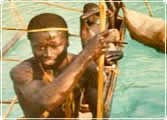 Around two million years ago, a human ancestor, Homo habilis, (sometimes called “handy man”, because of his use of tools) learned successfully to hunt animals for food. Evidence from skulls and teeth indicates that forerunners of H.habilis had a tough, fibrous vegetarian diet.
Around two million years ago, a human ancestor, Homo habilis, (sometimes called “handy man”, because of his use of tools) learned successfully to hunt animals for food. Evidence from skulls and teeth indicates that forerunners of H.habilis had a tough, fibrous vegetarian diet.
Some 500,000 years later, Homo erectus (“upright man”) had evolved and successfully developed language, tools, weapons and fire. They were similar in body proportion to modern humans, but sturdier and much stronger, and were successful as a species for 1.5 million years.
Modern humans, Homo sapiens sapiens, (“intelligent man”) appeared during the period 500,000-200,000 years ago, and continued to develop their means of subsistence and communities.
The first historical (as opposed to palaeontological) evidence of animals actually kept rather than hunted for food, shows that there was a grdual transition from hunting and food gathering to a dependence on food production. Domestic meat supplies were augmented by fish and wildfowl as well as by the meat of hunted wild animals. Carbon-14 testing of animal and plant remains have dated finds of:
- domesticated sheep at 9000 BCE in northern Iraq
- cattle in the 6th millennium BCE in north-eastern Iran
- goats at 8000 BCE in central Iran
- pigs at 8000 BCE in Thailand and 7000 BCE in Thessaly
- onagers, or asses, at 7000 BCE in Jarmo, Iraq
- and horses at 4350 BCE in Ukraine.
The llama and alpaca were domesticated in the Andean regions of South America by the middle of the third millennium BCE.
 Discussion Task:
Discussion Task:
 In a few isolated parts of the world people still depend on hunting animals and gathering wild plant material for subsistence. Examples include the isolated tribes indigenous to the Sentinel islands in the Indian Ocean. Although it is thought that many of these people survived the
In a few isolated parts of the world people still depend on hunting animals and gathering wild plant material for subsistence. Examples include the isolated tribes indigenous to the Sentinel islands in the Indian Ocean. Although it is thought that many of these people survived the  South Asian tsunami of 2004, some experts believe that the devastation to their habitat may lead to their eventual extinction. The Sentinelese fired arrows at the helicopter that flew over their island checking for survivors after the tsunami. No-one has any idea of their population (estimates range from 50 - 250), and landing on the island is impossible .
South Asian tsunami of 2004, some experts believe that the devastation to their habitat may lead to their eventual extinction. The Sentinelese fired arrows at the helicopter that flew over their island checking for survivors after the tsunami. No-one has any idea of their population (estimates range from 50 - 250), and landing on the island is impossible .
- Should efforts be made to help them?
- Although the tsunami was the largest on record, should such tribes as the Sentinelese be left to their own ways of coming to terms with such a natural distaster?
- What if this means that they all die?
- Should outsiders “rescue” them?

 Selective breeding
Selective breeding

What's your opinion?
Average rating




Not yet rated